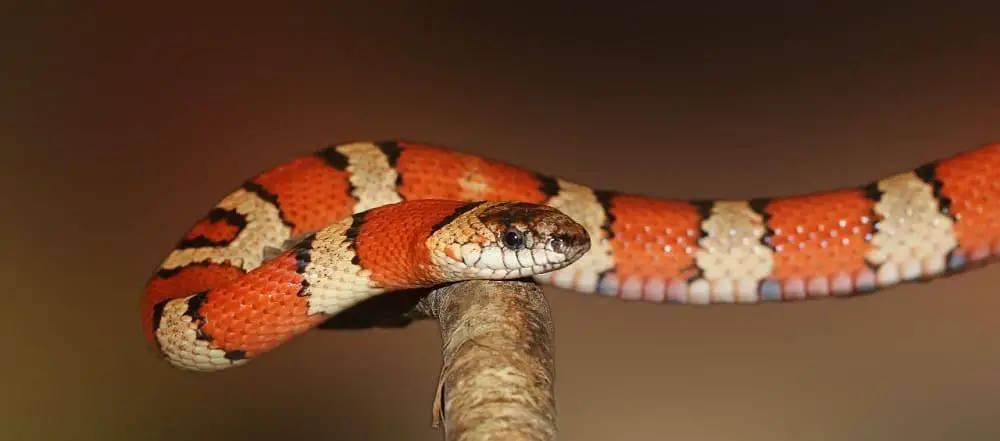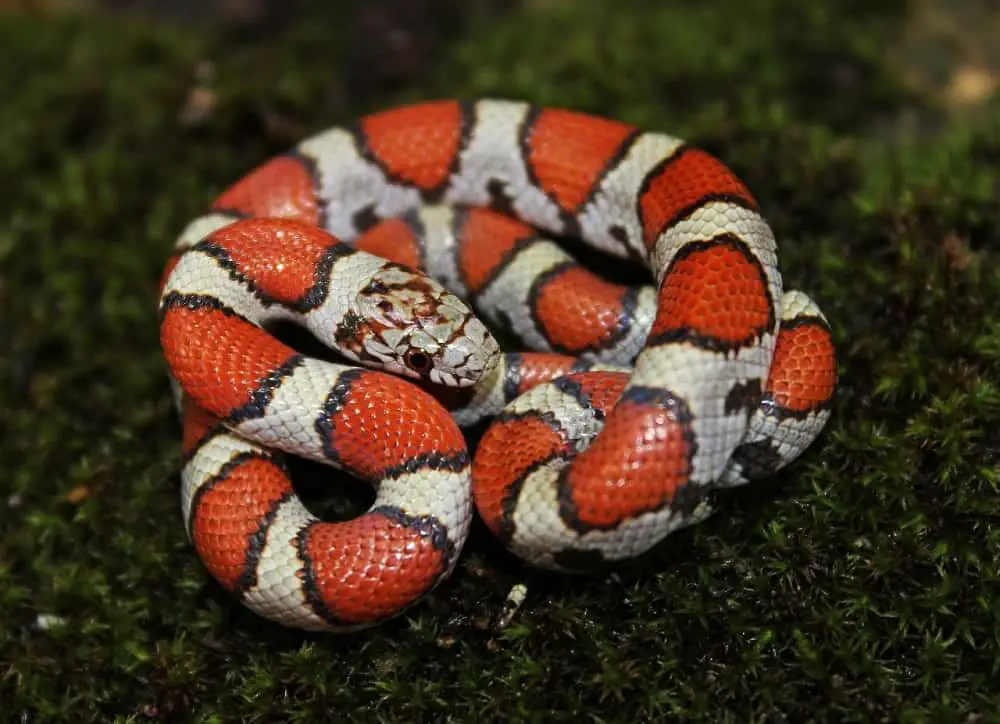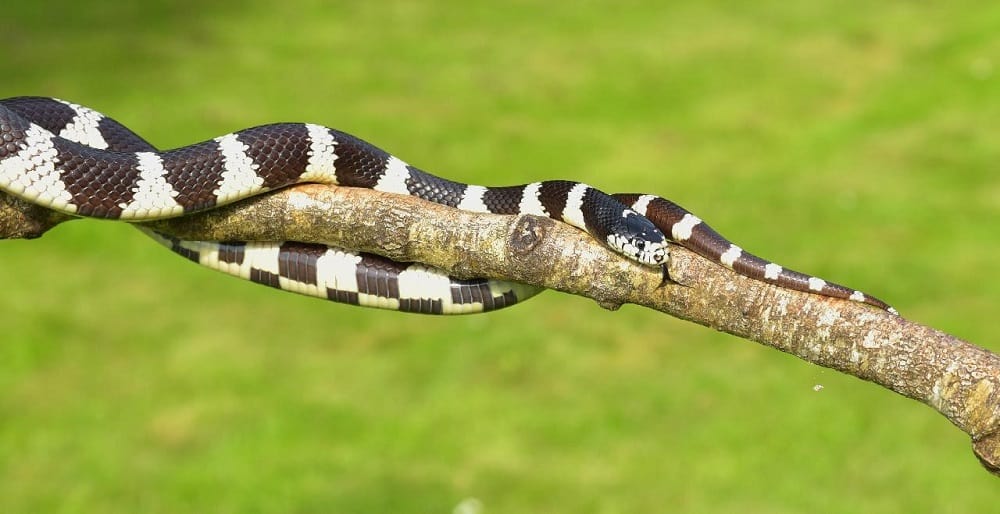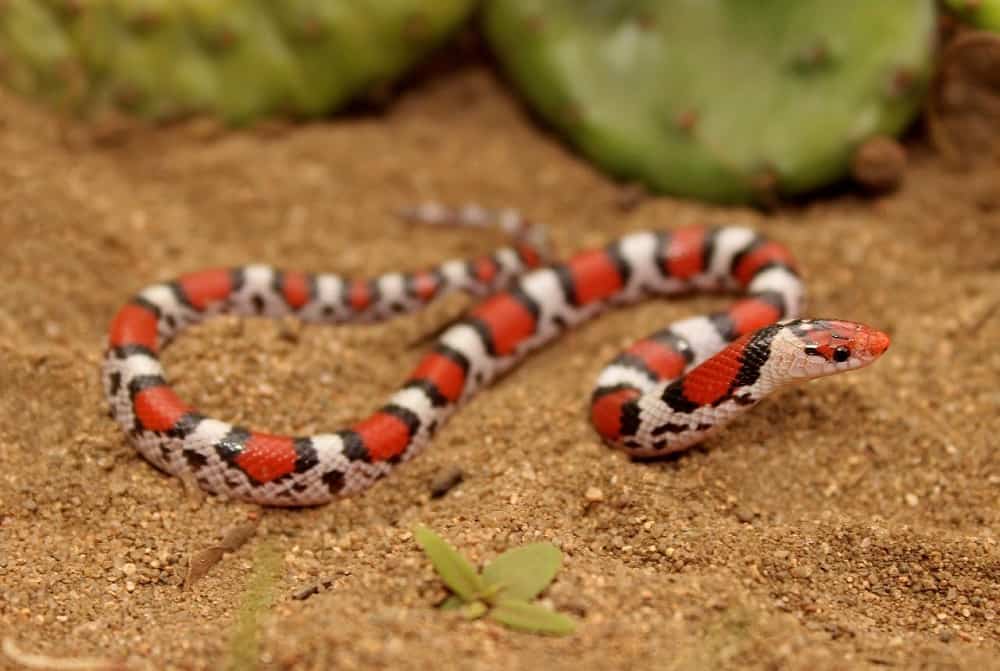
Kingsnakes are some of the most gentle-natured and calm snakes in the world. They’re all non-venomous and subdue their prey via constriction. This is why they have been encouraged as one of the nicest pet snakes to own, even for newer snake owners. But exactly how many types of kingsnakes are there? And which ones make for the best pets?
Whether you’re looking to own one of these docile creatures or simply want to know more about them, this article is for you. Let’s dive right in and have a look at some of the different types of kingsnakes.
Table of Contents
1. Milk Snake

Milk snakes are brightly colored and beautifully patterned nonvenomous New World snakes. Milk snakes are classified into 24 subspecies.
Milk snakes got their name from a folktale about a snake slithering into a barn and drinking the milk from nursing cows; however, this story has no basis in truth and is completely impossible because snakes do not possess lips and cannot absorb that much milk.
Appearance
Milk snakes vary in appearance and colors among the 24 subspecies, but they all have banded coloration. These bands might be white, red, or black in hue, and alternating bands of different colors are prevalent.
They might use white, yellow, or orange to separate the colored bands. The darker stripes have a black outline. The necks of many milk snakes have a light-colored Y or V form.
Milk snakes range in length from 14 to 69 inches. Central and South America are home to the world’s longest snakes. Milk snakes do not exceed 51 inches in length in the United States and Canada.
Milk snakes have smooth scales that are arranged in 19 to 23 rows. There is only one anal plate on these snakes. Males and females of milk snakes are sexually alike, meaning they reach the same length and all have the same colors and patterns.
Milk snakes have circular pupils, like many other nonvenomous snakes.
Habitat
Milk snakes have the largest geographic distribution of any snake in North America, much exceeding that of other snakes. They may be found all the way from Ontario and Quebec to Venezuela in the north. These snakes may also be found all across Mexico and Central America. They also inhabit many different areas throughout the United States, except for the West Coast.
Milk snakes must be able to survive in a variety of settings due to their wide range. According to the Savannah River Ecology Laboratory, they prefer wooded settings but are equally at home in fields, rocky outcroppings, agricultural regions, and barns.
They prefer to spend their days hiding beneath rocks, boards, or in the darkest corners of barns.
Behavior
Milk snakes are mostly nocturnal and solitary reptiles and are most active at night and dusk. They go out throughout the day if it’s damp or chilly outside and like to hide behind rocks, logs, or burrows during hot days.
They’re low-maintenance snakes, making them a perfect species to keep in captivity or as pets. This snake seldom attacks humans; when it does, it’s frequently because it has confused a finger for a prey item.
The bite of a king or milk snake is not painful. It will try to flee the perceived danger if it feels threatened.
Diet
Milk snakes are predators that consume animals and birds, among other things.
Their most common prey include:
- Mice
- Rats
- Voles
- Lizards
- Snake eggs
- Bird eggs
- Coral snakes
Hunting Style
Like all kingsnakes, these snakes are constrictors. Milk snakes have a great amount of strength when it comes to constriction. They wrap around their prey until its heart stops beating due to a lack of blood supply.
The milk snake swallows its prey whole once it has died.
2. Mexican Black Kingsnake

The Mexican black kingsnake is a non-venomous colubrid snake that belongs to the common kingsnake subspecies. The Western black kingsnake is another name for this beautiful, docile species.
Appearance
The Mexican black kingsnake has a long, smooth body and a tiny oval-shaped head that is about the same size as the neck. They grow to be 3 to 4 feet long on average, although they can grow to be approximately 5 feet long in captivity.
Adult snakes weigh between 3 and 4 pounds. Their pupils are round, and their eyes are small black circles.
However, unlike the Eastern indigo snake, it is a popular myth that they are invariably jet black in hue. In reality, they’re a lovely glossy blackish or extremely dark chocolate color.
On several scales, young Mexican black kingsnakes feature little yellow dots. When the snake sheds its skin, the spotting fades a bit more each time, and by the time it reaches adulthood, the spotting is typically totally gone. Under the chin of the snake, some white dot patterns may persist.
Their scales also have a blue gleam, comparable to those of other snakes, such as the lovely Brazilian rainbow boa.
Habitat
From Northwestern Sinaloa and western Sonora, Mexico, to southeastern Arizona in the United States, the Mexican black kingsnake may be found in the Sonora and Sinaloa deserts. However, new research suggests that Mexican black kingsnakes in Arizona occasionally interbreed with California kingsnakes or desert black kingsnakes.
They are well suited to the desert and may be found in semi-desert rocky locations as well as semi-arid meadows.
Behavior
These snakes are often calm and adapt well to confinement, making them excellent pets. Mexican black kingsnakes have become popular pet snakes, especially among beginner collectors, due to their ease of care. Overall, kingsnakes are one of the most popular pet snakes, with the Boa constrictor coming in second.
When confronted or attacked, they will hiss and bite the presumed threat by rattling their tails in an attempt to simulate a rattlesnake. If a predator catches them, they may emit a foul-smelling musk or defecate in an attempt to deter the predator from eating them.
Diet
The Mexican black kingsnake is a carnivore like other snakes, but it’s also an opportunistic hunter who enters rodents and other small animal burrows in quest of prey. It eats mostly cold-blooded creatures such as lizards and snakes.
Black kingsnakes in Mexico are reported to be cannibalistic. They are superb predators of dangerous pit vipers since they are immune to the venom of the rattlesnakes that live in their environment.
Like King Cobra, they have the potential to consume other snakes. Thus their common name is “King.”
They will, however, hunt nearly any tiny animal that they can overpower, kill, and consume, such as:
- Rats
- Birds
- Frogs
They have several natural predators, including:
- Coyotes
- Foxes
- Feral cats
- Hawks
- Owls
3. California Kingsnake

The California kingsnake is a nonvenomous colubrid snake found in a range of environments in the western United States and northern Mexico. The California kingsnake is one of the most popular snakes in captivity due to its easy-to-care-for nature and a vast variety of color variations.
Appearance
The California Kingsnake may grow to be between 110 and 150 cm long, with a body that is uniformly broad throughout, with the head being somewhat wider than the neck. It comes in a variety of hues, but the most popular are black or brown bands with white or yellow tones.
On the south coast of California, a crossed-out color variant with a white or yellow stripe running down its back can be found. In some regions of California, a design variation without lateral bands and stripes is also popular.
Habitat
The natural habitat of the California Kingsnake is, as the name suggests, California, although they may also be found in Utah, Arizona, Nevada, and even North Texas. These snakes are a subspecies of the common kingsnake that is surprisingly small.
These snakes can exist in woods, deserts, chaparral, grassland, woodlands, rivers, farms, and even bushy suburban areas due to their adaptability. They are generally found up to 3200 feet, but in the Tehachapi Mountains region, they may be found up to 7,000 feet.
Behavior
In the coldest parts of its habitat, this snake is more active during the day. The California Kingsnake, on the other hand, becomes increasingly nocturnal as the temperature rises.
They normally burrow deep down during the winter and undergo brumation, which is a hibernation-like condition marked by reduced activity and sluggish metabolism.
This snake is a constrictor, which means it suffocates its food by squeezing them to death. It isn’t poisonous, but it is usually immune to the venom of other venomous snakes.
Because of their higher pace of development, juvenile snakes shed more frequently than adults, up to once a month. When it is in distress, it will hiss and shake its tail furiously or curl up and hide its head.
Many predators prey on the California kingsnake, including:
- Coyotes
- Opossums
- Hawks
- Owls
- Skunks
Diet
California kingsnakes are opportunistic predators who eat a variety of prey, including rodents, birds, lizards, and turtle eggs. They also prey on other venomous snakes since they are immune to the venom of many species.
Like King Cobra, they get their common name “King” from their capacity to consume other snakes. They eat snakes of the same species and are therefore cannibals. They scour the ground, behind rocks, and in plants for their prey through sight, detecting movement and scent.
California kingsnakes’ jaws are hinged, like those of many snakes, allowing them to swallow food larger than their heads.
4. Scarlet Kingsnake

The scarlet kingsnake, sometimes known as the scarlet milk snake, is a kingsnake species found in the southeastern and eastern United States. They are nonvenomous, like all other kingsnakes.
Although they appear similar to milk snakes, scarlet kingsnakes have bands that do not extend to their belly.
Appearance
Within their genus, scarlet kingsnakes are the tiniest of all the species. Scarlet kingsnakes have white, black, and crimson bands on their bodies when they are hatched. Within geographic locations where this is displayed, they produce varied colors of yellow as they age.
Furthermore, the yellowing is not uniform; rather, it progresses from lighter to darker pigmentation from the lowest scales to the dorsum, or “back,” resulting in several yellowish bands. Yellow pigmentation ranges from lemon through school-bus yellow, orange, and apricot and darkens with age.
Most adult Scarlet Kingsnakes are about 14-20 inches in length.
Habitat
Scarlet Kingsnakes prefer damp pinelands and mesic hammocks, but they may also be found in drier environments. They are nocturnal and like to hide beneath rocks, logs, and rubble. They are, however, good climbers and may be seen climbing in trees and on buildings on occasion.
Scarlet kingsnakes may be found in the southeastern and eastern United States. Despite their local abundance, they are rarely spotted due to their reclusive nature. This species can be found in suburban areas where development has encroached on suitable habitats.
Behavior
Scarlet Kingsnakes would often strike at the assailant and vibrate the tip of their tail rapidly, making a buzzing sound in dead leaves. If they are caught or trapped, they will bite the intruder and produce a foul-smelling musk from glands near the base of the tail. Some snakes, on the other hand, do not bite in self-defense.
Despite this, these snakes are not aggressive, and striking is only utilized as a last resort in defense.
Diet
Scarlet Kingsnakes eat and tiny snakes, which they constrict and kill. Larger individuals, on the other hand, are known to devour small animals and invertebrates, while neonates are known to eat tiny frogs and insects. These snakes tend to be the most active hunters at night.
The most common prey of the scarlet kingsnake includes:
- Smaller snakes
- Lizards
- Frogs
- Toads
- Mice
- Rats
- Voles
- Birds
- Bird eggs
Predators of this snake include:
- Birds of prey
- Larger snakes
- Mammals
Conclusion
These are just some of the types of kingsnakes that exist today. As you can see from the information above, these snakes are usually docile and easy to handle. They are non-venomous constrictors, and these qualities make them excellent snakes to be kept in captivity or as pets.
References:
Florida Museum: Scarlet Kingsnake
Britannica: Scarlet Kingsnake
Live Science: Milk Snakes
Live Science: Kingsnakes
